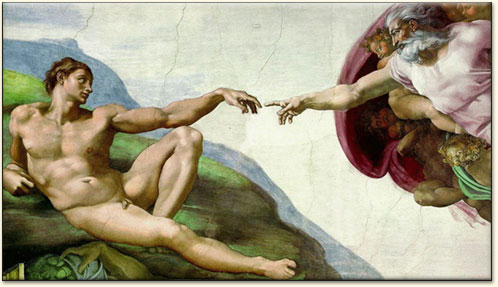Michelangelo’s Exaggerated Contrast: Cangiantismo
Just a few years after Leonardo da Vinci (1452-1519) achieved tonal unity, Michelangelo Buonarroti (1475-1564) tried a different approach. His colors are brilliant and contrasted, whereas da Vinci’s are subdued and unified. Michelangelo’s contours are crisp and set off against a contrasting background, whereas da Vinci’s blend and avoid silhouette.
Michelangelo mixes his colors with both black and white to maximize the contrast range for all the colors he uses. This means the lighter parts of each color (even the black of Joseph’s tunic) are almost white and unrealistically de-saturated.
The only color that has a high enough luminance in pure form is the yellow of Joseph’s cloak; Michelangelo does not have to de-saturate the yellow to get a high value. Therefore, the yellow robe has a different quality from all the others, the hues of which vary substantially in saturation and therefore look somewhat metallic. By using such a wide range of luminances, Michelangelo achieves vivid depth from shading. Still, both contemporaries and present day critics were surprised by his use of color. Why?
Michelangelo was the undisputed master of drawing in 16th century Italy. The cleaning of the Sistine Chapel ceiling and the Doni Tondo have revealed him to be a colorist of great originality, working with a fully-saturated palette. These “shot” effects (sometimes compared with “shot silk”) look forward to the work of Mannerist artists such as Jacopo Pontormo (1494-c.1556), Agnolo Bronzino (1503-1572), and Rosso Fiorentino (1495-1540), in whose hands they evoke a disquieting and emotive effect. However, this use of cangiantismo as it is known, goes back to the late 12th and 13th century art of Giotto, and later 15th century artists such as Andrea Mantegna (1431-1506). These are all artists working in Northern Italy or Florence who gave primacy to draughtsmanship.

The Creation of Adam. Michelangelo. 1508-1512.
Adam’s nude body is a good example of disegno, with muted coloring and masterful foreshortening.
Over the course of his lifetime, Michelangelo saw the real beginning of the controversy over the importance of drawing (disegno) versus color (colore). Although earlier writers, including Aristotle, had introduced this debate (line conveys rationality and order; color appeals to the senses), this now becomes a major issue to both writers and painters. A contemporary and admirer of Michelangelo, Giorgio Vasari (1511-1574), wrote Vite de’ più eccellenti architetti, pittori, et scultori Italiani (1550-68, The Lives of the Artists), in which he praised Michelangelo for his formal preparation involving endless drawings. This he contrasted with the work of some Venetians, such as Titian, who often worked out his compositions directly on the canvas. In Vasari’s estimation, these artists were giving undue importance to color. He quoted Michelangelo as saying that, while the color and style of the Venetians pleased him, “It was a shame that in Venice they did not learn to draw well.” There were many Venetian apologists and critics who responded to Vasari by pointing out that because contours do not exist in nature, color and shading are indispensable.
Debate about Michelangelo’s use of color has lasted for centuries. His use of color was criticized by 16th century Venetians as being “licentious” or unsuitable, and the recent restoration of Michelangelo’s ceiling has been criticized. Consider the lighting conditions, both then and now, and it will help to explain contemporary surprise – after the ceiling was restored - at Michelangelo’s unexpected use of vivid color.
Then, compare the Venetian manner of applying color – using richer, tonally related color with varied and expressive brushwork - with the cangiantismo of Michelangelo and other painters in northeastern Italy. (See also the exhibit "Feast of the Gods," and a discussion of Venetian art.) Does Michelangelo’s use of color add to the powerful effect of the figures?